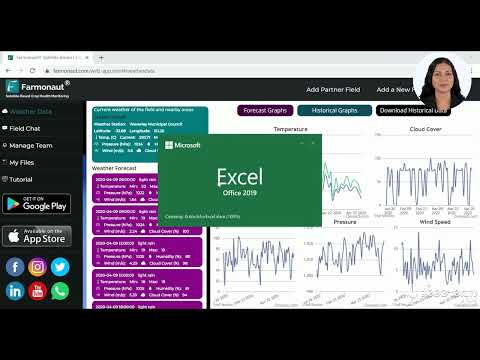Australian Crop Forecast: Late Rains and La Niña Impact on Southern Farmers
“Australian climate models predict a 60-80% chance of above-average rainfall in coming months, potentially developing into weak La Niña-like conditions.”
As we delve into the latest Australian crop weather forecast, we find ourselves at a pivotal moment for farmers across the southern regions of our vast continent. The interplay between late rains and the potential La Niña impact on agriculture has created a complex scenario that demands our attention. In this comprehensive analysis, we’ll explore how these weather patterns are shaping the future of farming in southern Australia and examine the innovative solutions emerging to help our rural communities navigate these challenges.
Understanding the Current Climate Conditions
The Bureau of Meteorology’s long-range weather forecasts have become a beacon of hope for many croppers and livestock farmers in Victoria, South Australia, and parts of Western Australia. These forecasts suggest a significant shift in the weather patterns that have been causing concern across the agricultural sector.
- 60-80% chance of above-average rainfall in coming months
- Potential development of weak La Niña-like conditions
- Critical implications for agricultural rainfall prediction
These predictions are particularly crucial for our farmers who have been grappling with drier-than-average conditions. The prospect of late rains could be a game-changer for crops that are currently struggling due to lack of moisture.

Satellite Crop Monitoring Reveals the Truth on the Ground
While forecasts provide hope, the reality on the ground tells a sobering story. Advanced satellite crop monitoring technologies, such as those offered by Farmonaut, have been instrumental in providing a clear picture of the current state of crops across Australia’s grain belt.
“Satellite crop monitoring reveals struggling crops in Australia’s grain belt, with some already failing due to lack of water.”
This data is crucial for several reasons:
- It allows for precise assessment of crop health across vast areas
- Helps in identifying regions most in need of rainfall
- Enables farmers to make data-driven decisions about resource allocation
The use of satellite technology in agriculture has revolutionized how we approach farming in challenging climates. By leveraging these insights, farmers can adapt their strategies in real-time, potentially salvaging crops that might otherwise fail.
The La Niña Phenomenon and Its Agricultural Implications
La Niña, the cool phase of the El Niño-Southern Oscillation (ENSO) cycle, has a significant influence on Australia’s climate patterns. As we look at the potential development of weak La Niña-like conditions, it’s essential to understand what this means for our agricultural sector.
- Increased likelihood of above-average rainfall in eastern and northern Australia
- Potential for cooler daytime temperatures in southern regions
- Higher risk of tropical cyclones in the north
For farmers in Queensland and parts of New South Wales, La Niña often brings welcome rains. However, for our southern farmers, particularly those in Victoria and South Australia, the effects can be more varied and complex.
Precision Agriculture Technology: A Lifeline for Farmers
In the face of these climatic uncertainties, precision agriculture technology has emerged as a critical tool for farmers. Companies like Farmonaut are at the forefront of this agricultural revolution, offering solutions that help farmers navigate the complexities of modern farming.
Key benefits of precision agriculture include:
- Real-time crop health monitoring
- Optimized resource management
- Data-driven decision-making capabilities
By utilizing these advanced technologies, farmers can:
- Identify areas of their property that require immediate attention
- Predict potential crop failures before they occur
- Implement targeted interventions to improve crop yields
The integration of satellite data, AI-driven analytics, and on-the-ground expertise is transforming how we approach agriculture in Australia’s variable climate.
Climate Models and Their Role in Agricultural Planning
The development and refinement of climate models have become increasingly crucial for the agricultural sector. These sophisticated tools provide invaluable insights that help shape farming strategies across the country.
- Long-term weather pattern predictions
- Seasonal rainfall forecasts
- Temperature trend analyses
For our farmers in southern Australia, these models offer a glimpse into potential future conditions, allowing for more informed decision-making regarding:
- Crop selection and planting times
- Water management strategies
- Livestock planning and feed forecasting
By leveraging these climate models, farmers can better prepare for the challenges and opportunities that lie ahead, potentially mitigating some of the risks associated with changing weather patterns.
The Impact on Southern Australia Farming Conditions
The potential for late rains and La Niña-like conditions presents a mixed bag for farmers in southern Australia. While the prospect of increased rainfall is generally positive, the timing and intensity of these rains can have varied effects on different agricultural sectors.
- Grain crops may benefit from late-season moisture
- Livestock farmers could see improved pasture growth
- Horticulture may face challenges with excess moisture and disease pressure
It’s crucial for farmers to stay informed and adaptable as these conditions unfold. The use of precision agriculture technology and satellite crop monitoring can provide the real-time data needed to make swift, informed decisions as weather patterns shift.

Agtech Solutions for Drought Management
As we consider the possibility of continued dry conditions in some regions, despite the forecast for late rains, it’s essential to explore agtech solutions for drought management. These innovative technologies are becoming increasingly important for maintaining farm viability in challenging climates.
- Smart irrigation systems for water conservation
- Drought-resistant crop varieties developed through advanced breeding techniques
- Soil moisture sensors for optimized water usage
Companies like Farmonaut are leading the charge in providing farmers with the tools they need to combat drought conditions effectively. Their satellite-based farm management solutions offer:
- Real-time crop health monitoring
- AI-based advisory systems for resource management
- Data-driven insights for strategic decision-making
By adopting these technologies, farmers can significantly improve their resilience to drought and other climate-related challenges.
Explore Farmonaut’s API for advanced agricultural data
Long-Range Weather Forecasts: A Farmer’s Crystal Ball
The Bureau of Meteorology’s long-range weather forecasts have become an indispensable tool for farmers across Australia. These forecasts provide a glimpse into potential future conditions, allowing for more strategic planning and risk management.
- Seasonal outlook for rainfall and temperature
- Probability maps for above or below average conditions
- ENSO (El Niño-Southern Oscillation) predictions
For our southern farmers, these forecasts are particularly crucial as they navigate the uncertainties of late rains and potential La Niña impacts. By integrating these long-range predictions with precision agriculture technology, farmers can create more robust and adaptive management strategies.
The Role of Satellite Technology in Modern Farming
Satellite technology has revolutionized the way we approach agriculture, offering unprecedented insights into crop health, soil conditions, and weather patterns. This technology is particularly valuable in the vast and varied landscape of Australia.
- High-resolution imagery for detailed crop analysis
- Multispectral data for assessing plant health and stress levels
- Large-scale monitoring capabilities for expansive agricultural regions
Farmonaut’s satellite-based solutions exemplify the power of this technology in action. By providing farmers with access to real-time, actionable data, these tools enable:
- Early detection of crop issues
- Optimized resource allocation
- Improved yield predictions and harvest planning
As we face the challenges of climate variability and the need for sustainable farming practices, satellite technology will continue to play a crucial role in shaping the future of agriculture in Australia.
Access Farmonaut’s API Developer Docs for integration guidance
Comparative Rainfall Forecast and Crop Impact
| Region | Rainfall Forecast | Potential Crop Impact and Recommended Strategies |
|---|---|---|
| Western Australia | 60-70% chance of above-average rainfall | Improved wheat yields likely; consider late sowing of drought-resistant varieties |
| South Australia | 70-80% chance of above-average rainfall, weak La Niña-like conditions | Potential for increased barley production; monitor for increased disease pressure |
| Victoria | 65-75% chance of above-average rainfall | Possible boost to dairy pastures; prepare for potential waterlogging in low-lying areas |
Adapting to Changing Weather Patterns
As Australian farmers face the challenges of variable weather patterns, adaptation becomes key to maintaining productive and sustainable agricultural practices. The potential for late rains and La Niña-like conditions requires a flexible approach to farming that can respond quickly to changing circumstances.
- Diversification of crop types to spread risk
- Investment in water-efficient irrigation systems
- Adoption of climate-smart agricultural practices
By embracing these adaptive strategies and leveraging the power of agtech solutions, farmers can increase their resilience to climate variability and safeguard their livelihoods.
The Future of Australian Agriculture in a Changing Climate
As we look to the future, it’s clear that Australian agriculture will continue to face challenges and opportunities shaped by our changing climate. The integration of advanced technologies, sustainable practices, and adaptive strategies will be crucial for the continued success of our farming communities.
- Increased focus on climate-resilient crop varieties
- Growing importance of precision agriculture and data-driven decision making
- Emphasis on sustainable land and water management practices
By staying at the forefront of agricultural innovation and embracing tools like those offered by Farmonaut, Australian farmers can position themselves to thrive in the face of climatic uncertainties.
Conclusion: Navigating the Path Forward
As we conclude our exploration of the Australian crop forecast and the potential impact of late rains and La Niña conditions on southern farmers, it’s clear that we’re at a critical juncture in agricultural management. The challenges posed by climate variability are significant, but so too are the opportunities presented by innovative technologies and adaptive farming practices.
Key takeaways include:
- The importance of staying informed about long-range weather forecasts and climate models
- The value of precision agriculture technology in optimizing farm management
- The need for flexibility and adaptability in farming practices
- The potential for satellite crop monitoring to provide crucial insights for decision-making
By embracing these insights and leveraging the power of agtech solutions like those offered by Farmonaut, Australian farmers can navigate the uncertainties of our changing climate with greater confidence and resilience.
FAQ Section
Q: How accurate are long-range weather forecasts for agricultural planning?
A: Long-range forecasts provide probabilistic outlooks rather than definitive predictions. While they offer valuable insights for general planning, they should be used in conjunction with shorter-term forecasts and on-ground observations for more precise agricultural decision-making.
Q: What is La Niña, and how does it affect Australian agriculture?
A: La Niña is a climate pattern characterized by cooler-than-average sea surface temperatures in the central and eastern tropical Pacific Ocean. In Australia, it typically brings increased rainfall to northern and eastern regions, which can benefit some agricultural areas but may also increase the risk of flooding.
Q: How can satellite crop monitoring help farmers during uncertain weather conditions?
A: Satellite crop monitoring provides real-time data on crop health, soil moisture, and vegetation indices. This information allows farmers to identify problem areas quickly, optimize resource allocation, and make informed decisions about irrigation, fertilization, and pest management.
Q: What are some effective drought management strategies for Australian farmers?
A: Effective drought management strategies include implementing water-efficient irrigation systems, selecting drought-resistant crop varieties, practicing conservation tillage, and utilizing precision agriculture technologies for optimized resource use.
Q: How can farmers access and use Farmonaut’s agricultural technology solutions?
A: Farmers can access Farmonaut’s solutions through their web application, mobile apps (available on Android and iOS), or API integration. These platforms provide various tools for crop monitoring, weather forecasting, and farm management to help farmers make data-driven decisions.






